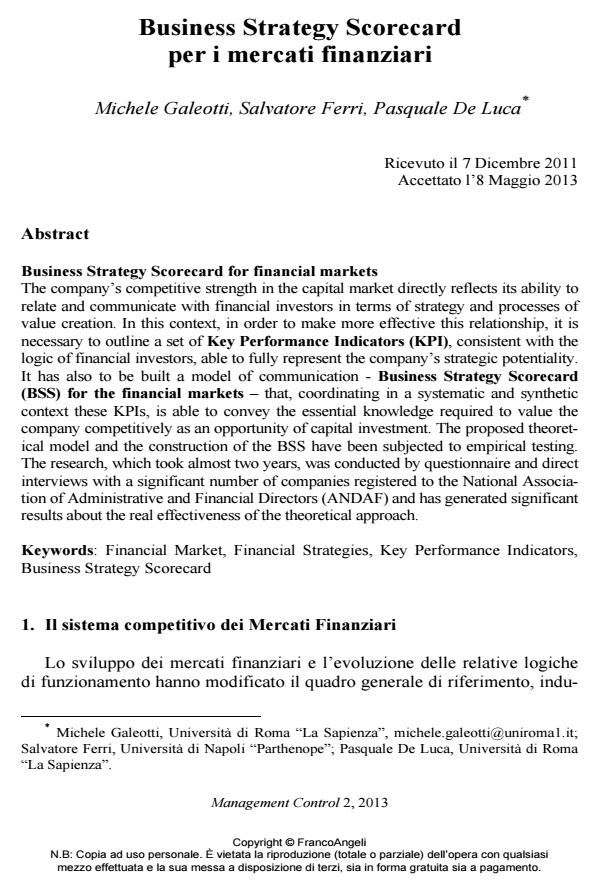Business Strategy Scorecard for financial markets
Journal title MANAGEMENT CONTROL
Author/s Michele Galeotti, Salvatore Ferri, Pasquale De Luca
Publishing Year 2013 Issue 2013/2 Language Italian
Pages 28 P. 39-66 File size 755 KB
DOI 10.3280/MACO2013-002003
DOI is like a bar code for intellectual property: to have more infomation
click here
Below, you can see the article first page
If you want to buy this article in PDF format, you can do it, following the instructions to buy download credits

FrancoAngeli is member of Publishers International Linking Association, Inc (PILA), a not-for-profit association which run the CrossRef service enabling links to and from online scholarly content.
The company’s competitive strength in the capital market directly reflects its ability to relate and communicate with financial investors in terms of strategy and processes of value creation. In this context, in order to make more effective this relationship, it is necessary to outline a set of Key Performance Indicators (KPI), consistent with the logic of financial investors, able to fully represent the company’s strategic potentiality. It has also to be built a model of communication - Business Strategy Scorecard (BSS) for the financial markets - that, coordinating in a systematic and synthetic context these KPIs, is able to convey the essential knowledge required to value the company competitively as an opportunity of capital investment. The proposed theoretical model and the construction of the BSS have been subjected to empirical testing. The research, which took almost two years, was conducted by questionnaire and direct interviews with a significant number of companies registered to the National Association of Administrative and Financial Directors (ANDAF) and has generated significant results about the real effectiveness of the theoretical approach.
Keywords: Financial Market, Financial Strategies, Key Performance Indicators, Business Strategy Scorecard
- Black E., Jensen M.C., Scholes M., (1972), The Capital Asset Pricing Model: some empirical tests, in Jensen M.C., a cura di, Studies in Theory of Capital Markets, New York, Praeger.
- Bianchi Martini S. (1996), La politica dei rischi nel sistema delle decisioni finanziarie d’azienda, Pisa, Il Borghetto.
- Brealey R.A., Myers S.C. (1990), Principi di finanza aziendale, Milano, McGraw-Hill.
- Coda V. (1988), L’orientamento strategico dell’impresa, Torino, Utet.
- Collins D.J., Montgomery C.A. (1990), Corporate strategy, Milano, McGraw-Hill.
- Copeland T., Koller T., Murrin J. (2002), Il valore dell’impresa. Strategie di valutazione e gestione, Milano, Il Sole 24 Ore.
- Damodoran A. (1996), Manuale di valutazione finanziaria, Milano, McGraw-Hill.
- Donna G. (1999), La creazione del valore nella gestione dell’impresa, Roma, Carocci.
- Fiori G., Tiscini R. (2005), Corporate Governance, regolamentazione contabile e trasparenza dell’informativa aziendale, Milano, FrancoAngeli.
- Galeotti M. (2008), Le strategie competitive dell’azienda nei mercati finanziari, Roma, Aracne.
- Galeotti M., Garzella S., a cura di (2012), Il governo strategico dell’azienda, Roma, Giappichelli.
- Godfrey P.C., Merril C.B., Hansen J.M. (2009), The relationship between corporate social responsibility and shareholder value: an empirical test of the risk management hypothesis, Strategic Management Journal, 30, pp. 425-445. DOI: 10.1002/smj.750
- Greenwood R., Schor M. (2009), Investor Activism and takeovers, Journal of Financial Economics, 92, pp. 362-375. DOI: 10.1016/j.jfineco.2008.05.005
- Guatri L. (1998), Trattato sulla valutazione delle aziende, Milano, Egea.
- Hofer W., Schendel D. (1984), La formulazione della strategia aziendale, Milano, FrancoAngeli.
- Invernizzi G., Il sistema delle strategie a livello aziendale, Milano, McGraw-Hill.
- Lev B. (2012), Winning Investors over, Harward Business Review Press.
- Kaplan R.S., Norton D.P. (2000), Balanced Scorecard. Tradurre la strategia in azione, Torino, Isedi.
- Karamanou I., Nishiotis G.P. (2009), Disclosure and cost of capital: evidence from the market’s reaction to firm voluntary adoption of ias, Journal of Business Finance and Accounting, 36, pp. 793-821. DOI: 10.1111/j.1468-5957.2009.02154.x
- Klein A., Zur E. (2009), Entrepreneurial shareholders activism: hedge funds and ather private investors, The Journal of Finance, 64, pp. 187-229. DOI: 10.1111/j.1540-6261.2008.01432.x
- Kotler P., Kartajaja H., Young S.D. (2007), Come attrarre gli investitori. Raccogliere capitali per il proprio business con le regole del marketing, Milano, Il Sole 24 Ore.
- Porter M.E. (1982), La strategia competitiva. Analisi per le decisioni, Bologna, Edizioni della Tipografia Compositori.
- Rispoli M. (1998), Sviluppo dell’impresa e analisi strategica, Bologna, il Mulino.
- Sharpe W.F. (1964), Capital asset process: a theory of market equilibrium under condition of risk, Journal of Finance, 19.
- The Going-Concern-Principle in Non-Financial Disclosure Rosa Lombardi, pp.79 (ISBN:978-3-030-81126-6)
- The Going-Concern-Principle in Non-Financial Disclosure Rosa Lombardi, pp.1 (ISBN:978-3-030-81126-6)
Michele Galeotti, Salvatore Ferri, Pasquale De Luca, Business Strategy Scorecard per i mercati finanziari in "MANAGEMENT CONTROL" 2/2013, pp 39-66, DOI: 10.3280/MACO2013-002003